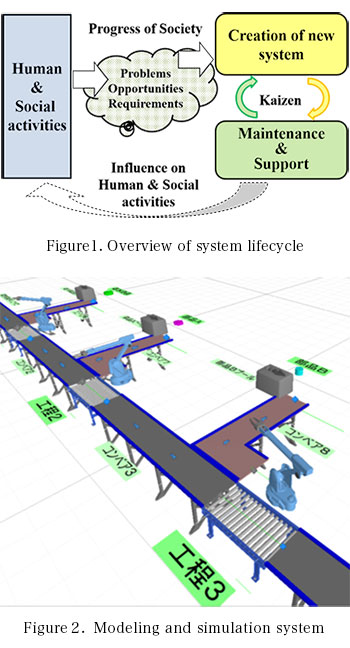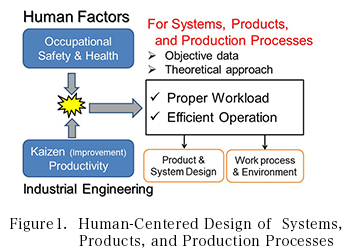Introduction of the Researches
Information and Mathematical Systems Laboratory(Ishii Laboratory)

Our society has evolved over many years by repeating system lifecycles consisting of finding and solving social problems, opportunities, and requirements, as shown in Figure 1. The Information and Mathematical Systems Laboratory is engaged in the scientific and engineering research for finding and solving social problems from the system lifecycle points of view so as to contribute to the sustainable social progress. Namely, we make studies on the several topics for the creation of new systems, such as the systems analysis and modeling to describe and identify the to-be model of new systems, the reliabilityengineering to create sustainable systems, and management systems to use the developed systems effectively. In addition, we study project management to create new systems effectively under the constraints, such as human resources, funds, and time. Regarding the maintenance and support of production systems, we make studies on the process analysis and Kaizen, including the line control systems and the operation algorithm, for improving the productivity and cost reduction of production systems using modeling and simulation systems as shown Figure2. In addition, we will work on the supply chain management system that control the production, sales, and inventory through the supply chain, by using the IoT and AI technologies.
Management System Engineering Laboratory(Katagiri Laboratory)

Owing to the progress of globalization caused by the rapid development of ICT, many difficult problems that need to be solved in large-scale complex systems have emerged. These problems are difficult because of the uncertainty of the environment and the diversity of individuals and organizations. To provide new technologies and valuable concepts for decision making methods, we conduct studies on systems optimization under uncertainty, data analysis, or business analytics based on soft computing, artificial intelligence, and machine learning. In cooperation with companies and other research institutes, we have performed several collaborative research projects to solve problems in manufacturing and in service industries such as tourism, medicine, and health.
Nonlinear Systems Laboratory(Kubotani Laboratory)
A best-selling product will often sell well because consumers know that it is selling well. This shows that consumers are affected by each other. If behaviors of the consumers go along with, a social tendency arises as a result of the summation of many individual personal activities. This phenomenon is similar to a macroscopic magnet, which is composed of many aligned magnetic spins. This type of phenomenon can be observed in human society and in nature.
For the study of a complex system that consists of many interacting elements, it is modeled in a nonlinear system. In our laboratory, we study a complex system that consists of many interacting elements. To reveal properties of the system, we use nonlinear systems theory and statistical science. We usually build a nonlinear system model of the complex system and estimate its validity through computer simulations.
Social Behavior Science Laboratory(Hisamune Laboratory)
Our objective is to enhance quality of life and to promote well-being by analyzing the relationship between humans and products/systems in terms of ergonomics and industrial engineering. In particular, to address challenges presented by the aging Japanese population, human-centered design should be considered with respect to universal and diversity. Thus, we focus on healthcare services, smart cities, and other subjects. For example, we analyze and improve the workplace practices of healthcare workers at long-term care facilities. We develop assistive and preventive systems for elderly people or patients by analyzing human movements. In addition, we investigate management of energy supply, transportation, and healthcare in smart cities.
Production and Operations Management Laboratory(Weng Laboratory)
Our laboratory aims to develop new production and management methodologies for manufacturers to deal with mass customization. Our research target includes maintaining high efficiencies of service and productivity for those manufacturers who take global production and/or mass customization as their goals. Moreover, we propose to connect factories as a virtual factory so that even small- and medium-sized manufacturers can play a role and obtain more opportunities to enlarging their value.
Manufacturing Systems Engineering Laboratory(Sato Laboratory)

The Manufacturing Systems Engineering Laboratory is engaged in research related to developing production and service management systems with uncertainty. With the development of IoT(Internat of Things) system in recent years, consumer’s purchase behavior, inventory, facility equipment and many other information available in real time. In order for society to develop sustainably utilizing these information, it is necessary to develop a dynamic decision-making method to properly produce and provide goods and services for customers. This laboratory aims at sustainable development of society and realization of safe and secure purchasing environment by exploring analytical properties of optimal policy and developing a tool that make it simple to use for decision maker.
Human Factors & Ergonomics Laboratory(Takanokura Laboratory)

Our laboratory has studied “design based on user perspectives” to promote well-being and to improve the quality of daily and working life. We have devised novel design approaches to solve social issues through “design thinking.” Design thinking analyzes interactions between humans (users/consumers/workers/other actors) and social/artificial systems (service/software/hardware) in a diverse society and is aligned with the principles of sustainable development. We are focusing on UX/UI design, human-centered design, interface design with usability, consumer engagement and loyalty to build a better relationship between us and social/artificial systems. Current topics include UX design for food service, UI design to assist daily activities for disabled people, user-centered application of a social service robot in elderly care, and evidence-based product design and operation improvement to ensure long-term safety and health of users/workers.
Basic Technology Laboratory(Matsumoto Laboratory)
A bicycle wheel consists of a hub, spokes, nipples, and a rim. The rim deforms from a true circle to an irregular circle when a worker assembles the wheel. The rim must be a true circle for the wheel to be used safety. The worker needs to correct the deformed rim by relation between nipple position relative to the desired nipple rotation angle and rim displacements. I developed task support equipment to correct the deformed rim with these relation, so that the worker does not need to know them. The task support equipment shows the worker the intended nipple position for use in setting the nipple rotation angle. I measured the relation between the nipple rotation angle and the rim displacement and suggested a method to calculate the corrected rim displacements based on the relation. I created the hardware and software for the task support equipment and checked the performance of the task support equipment by correcting deformed rims. I developed a 2D laser range sensor system, consisting of a 2D laser range sensor and a mirror based ellipse. The 2D laser range sensor can simultaneously scan the front side of the object and the lateral sides of the object densely with the laser light reflected by the mirror. I examined design conditions for the mirror based on the relation between the sensor and the object in the sensor system. I designed and made the mirror according to the design conditions and constructed the system from the sensor and the mirror. I took the reflecting points on an object experimentally with the sensor system and checked the positions of the scanned reflecting points to evaluate the system.